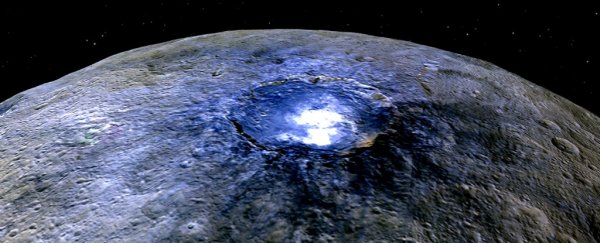NASA has announced that signs of organic material have been spotted on the surface of the Solar System's largest asteroid, the dwarf planet Ceres, adding to the long list of rocks in space containing complex, carbon-based molecules.
It seems like every other day astronomers are finding organic molecules on some asteroid, comet, or meteorite, so the discovery itself might not seem all that exciting – but it's what the orbiter didn't see that adds an intriguing level of mystery.
The material was spotted in and around the crater Ernutet on Ceres' northern hemisphere, using NASA's Dawn orbiting spacecraft.
Finding evidence of organic molecules on a major asteroid from an orbiting craft is a first in space exploration, and hints at exciting things to come.
"This is the first clear detection of organic molecules from orbit on a main belt body," said researcher Maria Cristina De Sanctis from the National Institute of Astrophysics in Rome.
However there are two features which should make us pay close attention to this recent find – the relatively fragile nature of the organic molecules, and the fact they weren't seen scattered all over the asteroid's surface.
Previous research had already shown Ceres possessed the right elemental ingredients for organic molecules, while signs of hydrated minerals, carbonates, and ammoniated clays provided evidence that water was active on and beneath the dwarf planet's surface.
Yet the materials spotted by the orbiting spacecraft's visible and infrared mapping spectrometer (VIR) were mostly limited to an area of about 1,000 square kilometres (400 square miles), with a few patches scattered just outside of the crater.
The immediate question is whether the material belongs to Ceres, or if it was left behind as another asteroid nose-dived into its surface.
Publishing their findings in Science, the team of researchers described the organic material as aliphatic, which could help rule out one of the possibilities.
Carbon tends to form two broad families of organic material – one in the form of rings called aromatics, the other as chains described as aliphatic.
Aromatic rings tend to be more robust than the aliphatic chains, which fall apart more easily under high temperatures, suggesting that such material would be unlikely to survive the high-energy impact of a crater-forming meteorite.
This is reflected in the abundance of aromatics in rocky 'chondrite' type meteorites, where chains of carbon are a relative rarity.
What's more, an impact would have mixed any foreign material into Cere's surface, making it even more unlikely that it would be seen as a distinctive spread of organic molecules.
With all signs pointing at a native origin for the chemicals, the next question is how it came to be scattered around Ernutet and nowhere else.
A clue there could lie in the abundance of carbonates and clays in the area. Just as hot springs bubble water to the surface of the Earth, Ceres has hydrothermal activity within its cold outer shell, seeding its surface with water heavily saturated with salts and nitrogen-bearing clays.
In fact, one of the dwarf planet's first big mysteries were a number of bright patches seen on its surface. The spots were initially assumed to be water ice, yet later figured to be mostly sodium carbonate salts deposited on the surface as brine squirted from a subterranean ocean sublimated in the cold near-vacuum.
Of course, there is still the mystery of why the aliphatic compounds have only been seen on this particular part of Ceres, which hopefully future studies could provide some insight into.
The fact Ceres has such a mix of water, organic material, and nitrogen is exciting for any scientist interested in the origins of life on Earth.
"This discovery adds to our understanding of the possible origins of water and organics on Earth," said Julie Castillo-Rogez, Dawn project scientist at NASA's Jet Propulsion Laboratory in Pasadena, California.
Asteroids provide a snapshot of our Solar System's early development, while also acting as tiny worlds slowly evolving in their own right.
While this might look like just another boring smear of carbon on some orbiting rock, its puzzling nature could hold clues on how organic material evolved into life here on Earth.
This research was published in Science.
